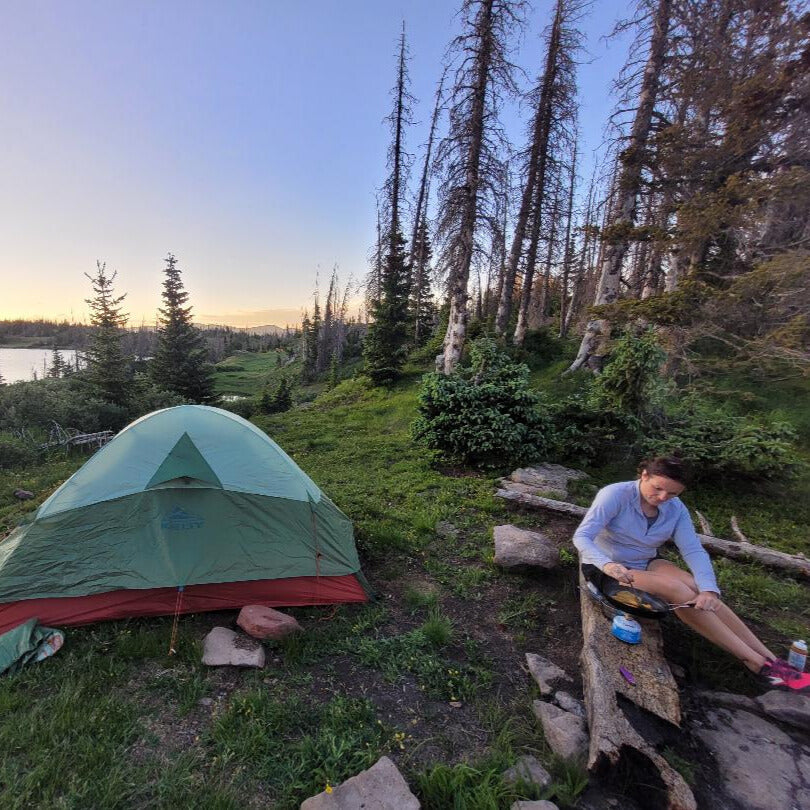Your Cart is Empty
accepting gear drop offs Mon-Sat 10am-5pm. No Consignment acceptance on Sundays.
accepting gear drop offs Mon-Sat 10am-5pm. No Consignment acceptance on Sundays.

When spending one night (or many) in the backcountry, a warm dinner at night and hot beverage in the morning can make the difference. That invariably involves using a stove of some sort–but which one?
Stove technology has been around for decades, but new tech is making them lighter, more efficient, and more dependable than ever before. Here’s a rundown of the different kinds of backpacking stoves:
How they work: These lightweight stoves screw directly onto a pressurized fuel canister containing a blend of isobutane and propane.
Pros:
Easy to use—just twist on, open the valve, and light.
Lightweight and compact, perfect for short to medium trips.
Fuel is widely available.
Cons:
Fuel canisters can be expensive and aren’t always recyclable.
Performance drops in very cold temperatures or at high altitudes.
Hard to know exactly how much fuel is left in a canister.
Many stoves lack a way to precisely control heat output.
Best for:Weekend backpackers, thru-hikers, or anyone who wants a balance of convenience and efficiency.
How they work: These stoves combine a burner with a specialized cooking pot that locks in place, often with built-in heat exchangers for efficiency. Popular examples include Jetboil and MSR WindBurner.
Pros:
Incredibly fast boil times.
Wind-resistant and fuel-efficient.
All-in-one design reduces packing fuss.
Cons:
Bulkier than standard canister stoves.
Usually better for boiling water than for real cooking.
Higher upfront cost.
Best for: Solo hikers, cold-weather backpackers, and anyone who prioritizes speed and efficiency.
How they work: These stoves burn white gas (like MSR WhisperLite), unleaded gasoline, or other liquid fuels. They use a refillable fuel bottle pressurized by a pump.
Pros:
Work well in extreme cold and high altitude.
Fuel is cheaper than canisters and widely available worldwide.
Refillable bottles are more sustainable than disposable canisters.
Cons:
Heavier and more complex than canister stoves.
Require priming and regular maintenance.
Not as compact.
More opportunities for a leak.
Best for: Winter trips, international travel, mountaineering, and long expeditions where reliability matters most.
How they work: These ultralight stoves burn denatured alcohol, HEET, or Everclear. Often made from soda cans or titanium cups, they’re a favorite of DIY backpackers.
Pros:
Inexpensive and easy to make yourself.
Super lightweight and simple.
Fuel is cheap and easy to find at gas stations or hardware stores.
Cons:
Slower cooking times.
Not efficient in cold or windy conditions.
Flame can be hard to see, which can be a safety issue.
Best for: Ultralight backpackers, minimalist hikers, and those on a budget.
How they work: These compact stoves burn small fuel tablets, often from Esbit.
Pros:
Extremely light and compact.
No moving parts, no maintenance.
Tablets are easy to carry and store.
Cons:
Slow cooking and limited heat output.
Strong chemical smell and residue.
Tablets can be expensive.
Best for: Emergency kits, ultralight hikers, or short trips where weight savings are critical.
How they work: These small stoves burn twigs, pinecones, and other natural fuel found on the trail. Some feature fans for added efficiency.
Pros:
No need to carry fuel—nature provides it.
Creates a campfire feel without a full fire ring.
Great for long trips where resupply is tough.
Cons:
Dependent on dry fuel sources (hard in wet weather).
Slower cooking and more smoky than gas stoves.
Not allowed in some areas due to fire restrictions.
Best for: Long-distance hikers, bushcrafters, and those who like a more natural camp experience.
Your perfect backpacking stove depends on the kind of trips you take most often:
Weekend hikers: Canister stoves are the sweet spot.
Thru-hikers: Many forgo stoves in favor of cold soaking; those that use them tend toward integrated canister systems to save weight and time.
Winter adventurers: Liquid fuel stoves thrive in the cold.
Minimalists: Solid fuel or wood-burning stoves keep it ultralight.
The used gear store in Durango,Durango Outdoor Exchange, has many kinds of new and used backpacking stoves as well as several sizes of low-priced fuel canisters. Stop by today to see them in person and learn more about backpacking stoves.

We’re all guilty of buying gear we don’t use or don’t use enough–and almost everyone has a closet that hasn’t been cleaned out in ages. With the new year here, now is the perfect time to declutter and turn unused gear into store credit or cash.
Durango Outdoor Exchange makes it easy to bring in your gear and let us sell it for you. Here’s your guide to decluttering your outdoor gear the smart way.

Work crews were busy over the off season making changes to ski areas across the region. While the hoped-for new lifts at Purgatory aren’t going to spin, there are plenty of reasons for you toget some wax (or new skis) from Durango Outdoor Exchange and hit the slopes this winter.

Thanksgiving is almost here–and skiing this early is always a gamble. Here are some non-skiing warm(er) weather destination ideas for the long break.